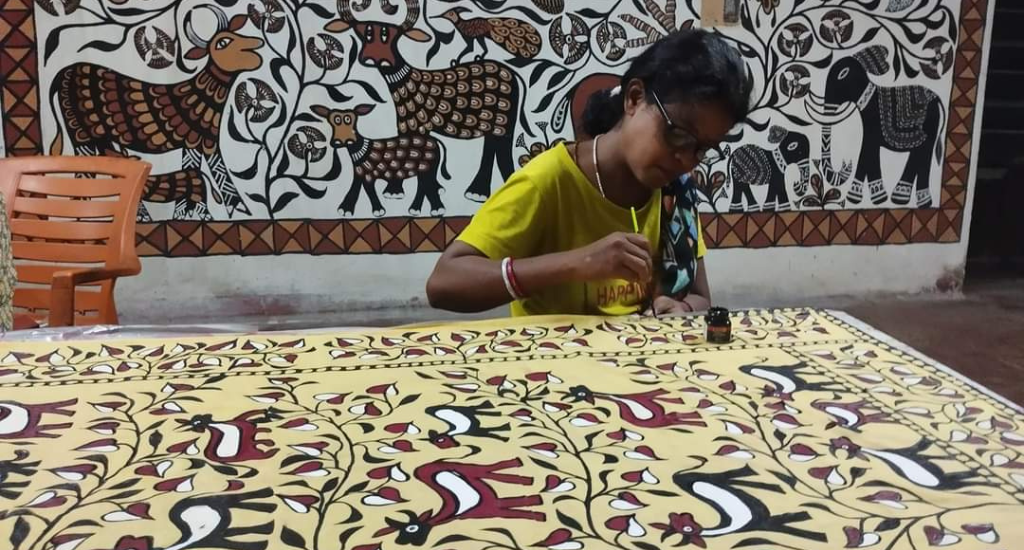
Jharkhand’s Sohrai art gets makeover for wider appeal
Jharkhand’s ancient Sohrai art, nurtured by Padma Shri Bulu Imam and his sons, transforms from rural murals to sarees and contemporary marvels at GI Fair India Expo and Mart 2023 in Noida

Jharkhand’s ancient Sohrai art, nurtured by Padma Shri Bulu Imam and his sons, transforms from rural murals to sarees and contemporary marvels at GI Fair India Expo and Mart 2023 in Noida
A recent journey to the GI Fair India Expo and Mart 2023 in Noida unveiled an enchanting revelation. Amidst the bustling event, the Sohrai art of Jharkhand emerged, not on traditional canvases but in the graceful form of sarees, transcending its rural origins to captivate a broader audience.
Jharkhand, nestled in the cultural mosaic of India, harbours the ancient Sohrai art — a tribal painting tradition ingrained in the villages of Hazaribagh. This art form, historically confined to adorning village walls, experienced a metamorphosis, stepping onto the contemporary stage through the passionate efforts of Padma Shri Bulu Imam and his sons, Justin and Gustav Imam.

Sohrai, rooted in the Mundari term “Soroi”, meaning “to lash with a stick”, offers a unique lens into the symbiotic relationship between Jharkhand’s tribal communities and their domestic animals, particularly cattle.
The paintings, traditionally passed from mothers to daughters, illuminate the intimate connection between villagers and their livestock, crucial for sustenance in agriculture.
Executed during the Sohrai festival, following Diwali, this art form distinguishes itself with its matrilineal tradition, celebrating the maternal bond through vibrant depictions of mother and child.
These paintings are done in the villages twice a year, following the rainy season and during weddings. Those made around Diwali came to be known as Sohrai, while those linked to weddings are called Kohbar.
Also Read: Saving Khovar and Sohrai arts of “painted villages”
Natural earth colours – red, black, yellow, and white – sourced from the wild or local markets, create a harmonious fusion of nature and tradition. The four primary colours are red ochre (Gerua mitti), yellow ochre (Pila mitti), manganese or powdered coal (Kali mitti), and white clay (Dudhi/Charak mitti). Sal tree twigs serve as brushes, cloth rags as canvas, crafting a rich tapestry.

The art’s historical significance deepened with the discovery of rock arts in ISCO village by Bulu Imam in 1991. Dating back to 3000-7000 BC, these Paleolithic-age artworks mirrored motifs found in the local homes, suggesting a cultural inheritance that spread the Sohrai art form throughout Hazaribagh.
The paintings, distinguished by their diverse motifs, reflect the artists’ surroundings, creating variations from village to village. Central to Sohrai’s thematic richness is the matriarchy, evident in depictions of pregnant animals and birds, emphasising maternal importance.
“Village women hold Sohrai art with immense pride. It serves both as a part of home decoration and an integral part of their cultural heritage,” said Justin Imam.
Bulu Imam’s transformative journey from a big game hunter to an environmental activist in the 1980s laid the foundation for preserving Jharkhand’s indigenous art. In 1993, he established the Sanskriti Museum and Art Gallery, showcasing Kohbar and Sohrai art. His global exhibitions garnered recognition, sparking a renaissance for this ancient tradition.
To amplify tribal art, Bulu Imam founded the Tribal Women Artists’ Cooperative in 1993, growing to more than 6,000 members. The Sohrai School, initiated by him, imparts this ancient art form to 60 children.
Also Read: Why is Jharkhand’s Paitkar scroll art losing colour?
In the contemporary era, Bulu Imam’s sons, Justin and Gustav, carry the torch. They’ve expanded Sohrai art beyond paintings, incorporating it into clothing, diaries, stoles, and greeting cards. Their innovative approach respects tradition while evolving with the times.

“We have brought this ancient tradition to a broader audience. Our innovative approach emphasises the need for art to evolve with the times while staying true to its roots,” said Justin Imam.
The GI Fair India Expo and Mart 2023 served as a grand stage for Sohrai art. Unexpectedly, it materialised in the form of sarees, an enthralling evolution from its conventional canvas. Tribal women, not renowned artists, led this transformation, making Sohrai art accessible to diverse audiences.
The journey from village walls to contemporary products signifies the resilience and adaptability of indigenous art. Thanks to Bulu Imam and his sons, Sohrai art not only endures but also thrives globally. This tale is a testament to the enduring spirit of tradition in the face of modernity, where cultural heritage evolves, mesmerising and inspiring generations.
The fair etched a new chapter in the history of Sohrai art, highlighting its timeless allure in the modern world.
Also Read: Indigenous art forms of Santhal Pargana are in need of revival
The lead image at the top shows a woman, trained by Bulu Imam’s family, painting on a saree (Photo by Monica Marandi)
Monika Marandi is an independent journalist based in Delhi. She is a Rural Media Fellow 2022 at Youth Hub, Village Square.